Arab Baths & Hammams in Granada - All You Need to Know

The Arab baths in Granada are reminiscent of the typical hammams of the Nasrid period, usually featuring a circuit of thermal waters, including hot, warm, and cold baths, as well as a Turkish bath.

Enjoy a special day at the Alhambra with a guided tour
 Alhambra and Nasrid Palaces: discover the wonders of the Alhambra with this all-inclusive tour: the Nasrid Palaces, the Generalife, the Alcazaba, and more.
Alhambra and Nasrid Palaces: discover the wonders of the Alhambra with this all-inclusive tour: the Nasrid Palaces, the Generalife, the Alcazaba, and more.
 Alhambra + Albaicín + Sacromonte: a perfect combination of a guided tour of the Alhambra in the morning and a guided tour of the Albaicin and Sacromonte in the afternoon.
Alhambra + Albaicín + Sacromonte: a perfect combination of a guided tour of the Alhambra in the morning and a guided tour of the Albaicin and Sacromonte in the afternoon.They are typically situated in charming historic buildings and offer a variety of services beyond bathing, such as massages or aromatherapy.
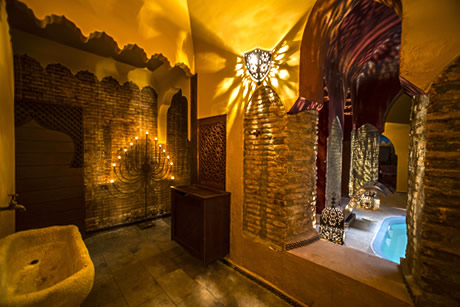 The rituals or circuits in the Arab Baths are special treatments that complement the bath experience
and can include various types of relaxing massages with essential oils, creams, and exfoliation with salts.
The rituals or circuits in the Arab Baths are special treatments that complement the bath experience
and can include various types of relaxing massages with essential oils, creams, and exfoliation with salts.
The duration varies depending on the type of massage you choose, with some lasting up to 90 minutes.
There are four Arab hammams in Granada, they all offer therapeutic showers, baths, massages, and other rituals.

It's a good idea to book online or call ahead before visiting to ensure they're open and to check for any capacity restrictions.
Remains of Very Ancient Arab Baths
Apart from the Arab baths where you can enjoy a sensual experience like in the hammam, Granada has several archaeological
sites where you can find remains of very old Arab baths.
Some are open to the public and can be visited; others, however, remain closed due to their delicate state of preservation.
After describing the best hammams in Granada, at the end of this page, we offer historical information if you're interested in the history of the Arab baths in Granada.
Hammam Al Ándalus in Granada - Arab Baths in Mudejar Style
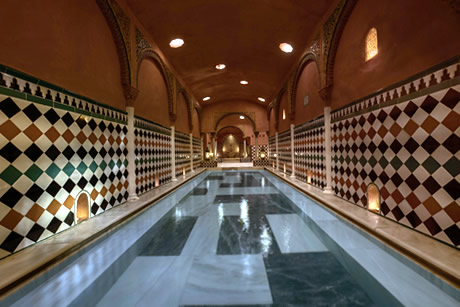 These Arab baths evoke the typical hammams of Muslim Granada, transporting you to another era.
These Arab baths evoke the typical hammams of Muslim Granada, transporting you to another era.
They have been beautifully restored in the old Mudéjar style. The Mozarabic touches evident in its arches, tiles, and vaults take advantage of the original architecture of the building.
It is a cozy place, decorated to the smallest detail, featuring dim lighting and soothing background music.
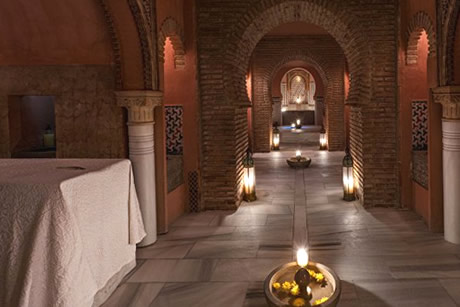 Its facilities are comprehensive, including several baths of varying sizes and temperatures,
Turkish baths, a fantastic large steam room, and heated stone slabs for relaxation.
Its facilities are comprehensive, including several baths of varying sizes and temperatures,
Turkish baths, a fantastic large steam room, and heated stone slabs for relaxation.
They offer aromatherapy massages with a selection of scents to choose from, along with the foam pillow treatment.
It offers well-equipped showers and changing rooms, complete with amenities such as hair dryers, cologne, hair gel, soap, shampoo, conditioners, creams, and more.
Treatments and Prices

▸ Emerge - Arab bath: 42 euros.
▸ Mimma 15 / 30 - Arab bath / relaxing massage 15 mins: 54 euros; 30 minutes: 67 euros.
▸ Mimma 30 and organic soy candle - Arabic baths / relaxing massage 30 mins: 75 euros.
▸ Mimma 45 / 60 - Arab bath / deep massage 45 mins: 83 euros; 60 minutes: 112 euros.
▸ Midra 30 / 45 - Arab bath / traditional Kessa 15 mins / relaxing massage, 15 mins: 75 euros; 30 minutes: 109 euros.
▸ Bauuah 30 - Arab bath / muscle stretching 30 mins: 76 euros.

Opening Hours of the Hammam Al Ándalus
The Hammam Al Ándalus open from Monday to Sunday in shifts of: 10:00, 12:00, 14:00, 16:00, 18:00, 20:00, 22:00 and 00:00.Contact Information
Address: Hammam Al Ándalus Arab Baths, Calle Santa Ana, 16, 18009 Granada.Situated next to Plaza Nueva, 2 minutes from the Cathedral. You can get there by urban bus, Line 4, Cathedral stop.
Reservations and Inquiries
More information, detailed prices and reservations at Hammam Arab Baths.Comares Palace Arab Baths - a replica of the Alhambra's Hammam
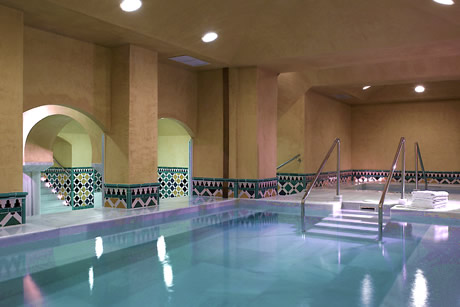 Situated in the Hotel Macia Real de la Alhambra, the Palacio de Comares Arab Baths are a replica of
the hammams of the Alhambra.
Situated in the Hotel Macia Real de la Alhambra, the Palacio de Comares Arab Baths are a replica of
the hammams of the Alhambra.
With its calm and evocative atmosphere, along with its beautiful Arabic-style decoration, it's an ideal place to relax and enjoy a special moment.
Its facilities include pools of warm and hot water, a jacuzzi, steam baths, cryotherapy, a relaxation area with tea service, and more.
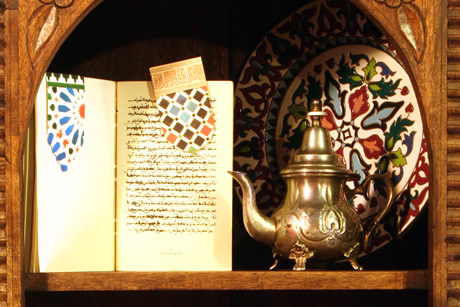 The Palacio de Comares baths offer various high-quality thermal circuits inspired by Nasrid style.
The Palacio de Comares baths offer various high-quality thermal circuits inspired by Nasrid style.
Additionally, it also offers massage services, rituals, and other complementary treatments to enhance the bathing experience.
Opening Hours
Open on Monday, Tuesday and Wednesday: from 17:00 to 21:00.Thursday, Friday, Saturday and Sunday: from 10:00 to 14:00 and from 17:00 to 21:00.

Treatments and Prices
▸ Arab Circuit + Tea Service (Couples): 35 €
▸ Arab Circuit + Massage of 15, 25, 55 min + Tea Service (Couples): 65 €, 90 €, 130 €
▸ Spa Circuit + Relaxing Chocolate Massage (Couples): 120 €
▸ Massages: Exclusivity massage (partial): 46 €; Exclusivity massage (complete): 62 €; Pindas massage: 72 €; Holistic massage: 80 €
▸ Rituals: Al Andalus ritual: 78 €; Geisha ritual: 80 €; Gold Therapy ritual: 80 €; Geothermal ritual: 85 €
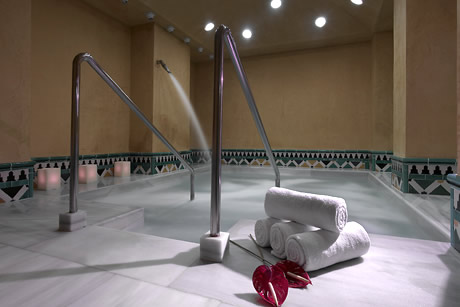
Contact Information and How to Get There
Address: 'Palacio de Comares' Arab Baths, Calle Mirador del Genil, 2, 18008 Granada.You can get there by urban bus: route 33. The stop is Ctra. de La Sierra 6. From the center (Fuente de las Batallas) it takes only about 15 minutes by bus.
Telephone: 635 467 375. Email: banosarabes@spaybelleza.com.
Make your experience in Granada even more complete and memorable
10 Best Caves and Venues for Flamenco in Granada: immerse yourself in the passion of flamenco and live unique experiences in the best tablaos in the city.
Authentic Arab Baths and Relaxing Massage: enjoy a deep relaxation experience with an exclusive massage in a traditional setting.
Baños de Elvira - a Cozy and Relaxing Place in the Heart of the City
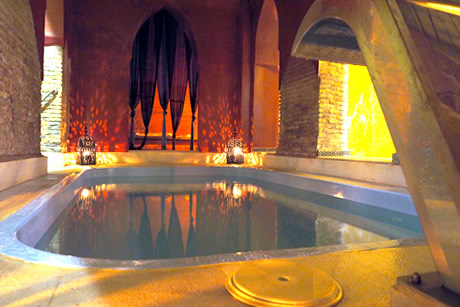 It's a small and cozy place located in the center of Granada.
It's a small and cozy place located in the center of Granada.
It features a hot water pool with jets and a waterfall, a small cold water pool, a Turkish bath, and a eucalyptus sauna.
Additionally, there is a relaxation area where you can unwind and enjoy fresh fruits, water, tea, and juice as part of the booking.
Beautiful interior, relaxed atmosphere, and a peaceful, serene space with Arabic music in the background and dim lighting.
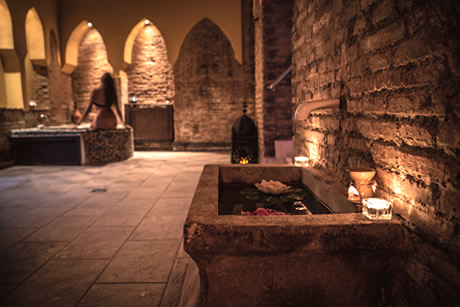 The service includes flip-flops, shampoo, gel, hairdryer, and other amenities to ensure your stay is a pleasant experience.
Additionally, they provide lockers for your convenience.
The service includes flip-flops, shampoo, gel, hairdryer, and other amenities to ensure your stay is a pleasant experience.
Additionally, they provide lockers for your convenience.
Like all Arab baths, Baños de Elvira offer several packages of relaxing treatments to complement the bathing experience.
Opening Hours
The Baños de Elvira Arab baths open from Monday to Sunday from 10:00 to 22:00.
Treatments and Prices
▸ Basic circuit - hot and cold water pool + Turkish bath: 30 euros. Duration 90 minutes.
▸ Thermal circuit - basic + relaxing massage of 15 min: 40 euros. Duration 90 minutes.
▸ Relax Circuit - basic + 30-minute relaxing massage: 50 euros. Duration 1 hour and 45 minutes.
▸ Special circuit for lovers - private relaxation circuit for 2 people with 1 hour of water session,
Cava baby and 30-minute massages each person: 180 euros for both.
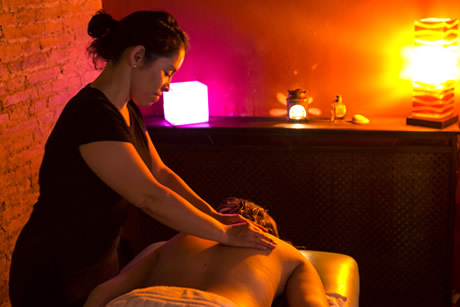
Contact Information
Address: Baños de Elvira, Calle Arteaga, 3, 18010 Granada.Located on Calle Arteaga, between Gran Vía and Calle Elvira. You can get there by urban bus, route 4, Sagrado Corazón stop.
Telephone: 618 996 804. Email: info@banosdeelvira.es.
Add a little magic to your day in Granada!
Find Your Ideal Experience: 100+ Tours and Activities in Granada:
Explore Granada with a variety of tours and activities, designed to help you discover the city in a fun and memorable way. There's something for everyone.
Explore Granada with a variety of tours and activities, designed to help you discover the city in a fun and memorable way. There's something for everyone.
Al-Haram Baths - A Hammam with a lot of history
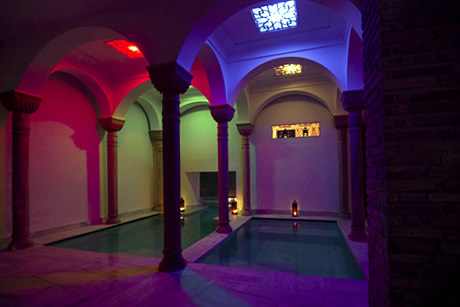 The Al-Haram Arab baths are situated in an old building in the historic center of the city.
The Al-Haram Arab baths are situated in an old building in the historic center of the city.
During restoration work, the remains of a 500-year-old water cistern were discovered. It is believed that this building once housed one of the many hammams of Nasrid Granada.
Immaculately clean, cozy, and beautifully appointed facilities with simple and elegant Arabic decoration. Candles are scattered throughout all the rooms, adding to the ambiance.
The music, the lighting, and the little tables decorated with rose petals transport you to another era.
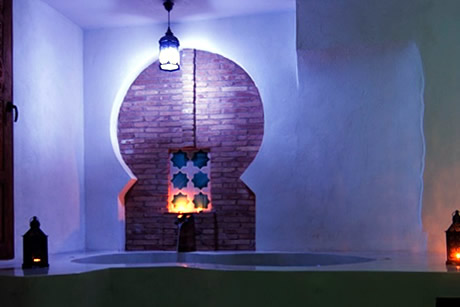 There is a spacious communal area and massage room, along with several baths offering different temperatures: cold, warm, and hot water, as well as a Turkish bath and a sauna.
There is a spacious communal area and massage room, along with several baths offering different temperatures: cold, warm, and hot water, as well as a Turkish bath and a sauna.
There are public and private circuits available. The massage rooms are private. They offer a variety of teas, fruits, dried fruits, and strawberries.
The changing rooms and showers are well-equipped, featuring amenities such as a hairdryer, shampoo, shower gel, deodorant, conditioner, and more.
Treatments and Prices
All rituals include a complimentary tour of the hot springs at varying temperatures.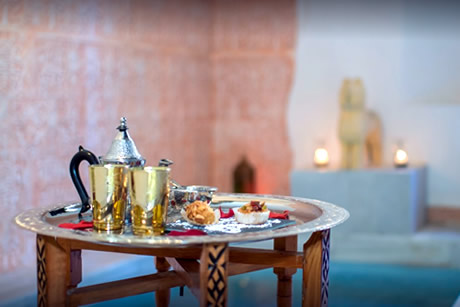
▸ Basic Bath + 15-minute massage: 32 euros.
▸ Basic Bath + 30-minute massage: 40 euros.
▸ Aixa Ritual – free tour + access to a private room + 15-minute massage: 49 euros.
▸ Boabdil Ritual – free tour + access to a private room + 15-minute massage + hot room with natural clay: 53 euros.
▸ Moraima Ritual – free tour + access to Aixa private room + 30-minute massage: 57 euros.
▸ Abu Said Ritual – free tour + access to Aixa private room + 30-minute massage + steam room: 62 euros.
▸ Granada Ritual – free tour + access to Aixa private room + 40-minute massage with natural wraps: 70 euros.

Opening Hours of the Al-Haram Arab Baths
Al-Haram Baths open Monday to Thursday from 16:00 to 22:00. Friday, Saturday and Sunday: from 12:00 to 22:00.Contact Information
Located between Plaza de la Encarnación and Gran Vía. It can be reached by urban bus, route 4, Marqués de Falces stop (on Gran Vía).Address: Al-Haram Baths, Calle Santa Paula 25, 18001 Granada. Telephone: 858 715 034. Email: info@alharamgranada.com.
Remains of Very Ancient Arab Baths
With the arrival of the Catholic Monarchs, the public buildings of Nasrid Granada gradually disappeared: the mosques, the madrasah, and the numerous Arab baths that were scattered throughout the city. Some were even older than the Nasrid ones.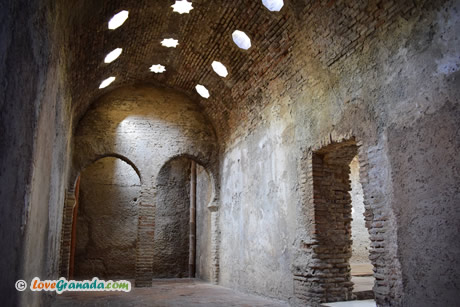 Hammams or Arab baths were very important public places; they served several fundamental social functions in
medieval Granada.
Hammams or Arab baths were very important public places; they served several fundamental social functions in
medieval Granada.
In addition to being places of public gathering and where the ablutions required by the Quran were performed, they helped the population maintain necessary hygiene, as most people could not carry out a full personal cleaning at home.
For this reason, there were public baths near the mosques, in every neighborhood, and in the Alhambra; both in the royal palaces and in the medina, where artisans, servants, and troops lived.
The Bañuelo (Zirí period, 11th century)
These 11th-century Arab baths are remarkable for their excellent state of preservation, size, and age. Located next to the Darro River, in front of the ancient Cadí Bridge, this hammam was known as the ‘Baño del Nogal'.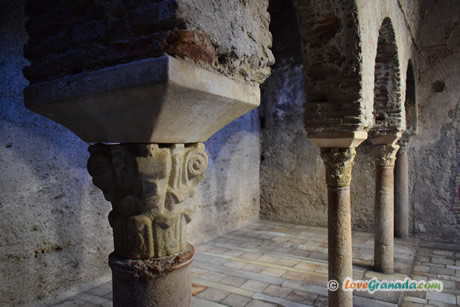 They were the public baths for the residents of the Axares neighborhood, within the old Alcazaba Cadima, where the
Zirid dynasty had
established its center of power and ruled before the Alhambra existed, in what is now
the Albaicin.
They were the public baths for the residents of the Axares neighborhood, within the old Alcazaba Cadima, where the
Zirid dynasty had
established its center of power and ruled before the Alhambra existed, in what is now
the Albaicin.
A visit to these baths is included in the combined tickets for the 'Dobla de Oro' and Andalusian Monuments, available for purchase on the Alhambra website.
It can be visited with the combined ‘Dobla de Oro' or ‘Monumentos Andalusíes' ticket. On Sundays, it's free. Find more information in the Bañuelo.
Palacio de Comares Arab Baths (Nasrid period, 14th century)
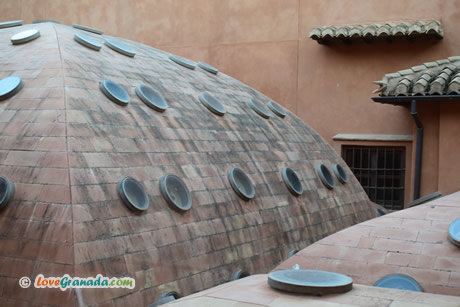 Located between the Comares and the Lions Palaces,
it is the best-preserved Islamic bath in the West and is almost entirely intact.
The Baño Real or Baño de Comares was built during the reign of Yusuf I, between 1333 and 1354.
Located between the Comares and the Lions Palaces,
it is the best-preserved Islamic bath in the West and is almost entirely intact.
The Baño Real or Baño de Comares was built during the reign of Yusuf I, between 1333 and 1354.
Originally, access was from the Patio de los Arrayanes, but this was altered with the construction of the Palace of Charles V, which occupied the entire southern area of the courtyard.
You can see the vestibule, where the beautiful room of the beds is located. In the center of the room, there is a basin surrounded by four columns and a gallery, which on the upper floor is closed off with latticework.
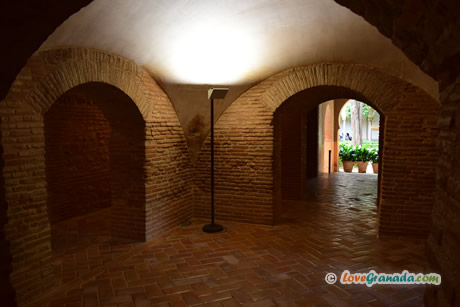 On its eastern and western sides, there are two small rooms separated by double arches supported by columns. The beautiful tilework
inside stands out, with various colors. This is where the beds were located, where people rested after the bath.
On its eastern and western sides, there are two small rooms separated by double arches supported by columns. The beautiful tilework
inside stands out, with various colors. This is where the beds were located, where people rested after the bath.
Most of the richly polychromed decoration is from the Christian period, as the bath was in very poor condition and underwent a long restoration from 1843 to 1866.
The interior of the Baño Real is simple and elegant: the walls, without decoration; the floors, made of white marble; smooth horseshoe arches and tile baseboards.
 The beautiful vaulted ceiling of this room is perforated with star-shaped skylights that, although covered with colored glass,
allowed the steam from the bath to escape. The vault can be admired from the outside.
The beautiful vaulted ceiling of this room is perforated with star-shaped skylights that, although covered with colored glass,
allowed the steam from the bath to escape. The vault can be admired from the outside.
The Baño de la Alhambra is known as the Baño Real because the Catholic Monarchs reserved it for their personal use when they arrived in Granada. It is the only one that has been preserved, but it is known that each palace in the Alcazaba had one.
Today, although it is closed to the public, it can be glimpsed from the Patio de Lindaraja and a few other spaces if you visit the Nasrid Palaces.
Mezquita Mayor Baths in the Alhambra (Nasrid period, 14th century)
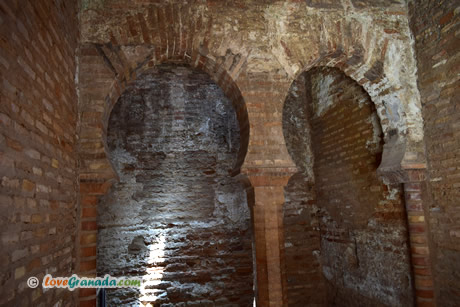 Muhammad III (1302-1309) built this bath next to the Mezquita Real de la Alhambra. It was destroyed in 1534, and its remains are
now inside the house that is currently the Ángel Barrios Museum.
Muhammad III (1302-1309) built this bath next to the Mezquita Real de la Alhambra. It was destroyed in 1534, and its remains are
now inside the house that is currently the Ángel Barrios Museum.
The Arab baths have a bent entrance, and the first thing we see is the room that served as a changing room in the hammam, illuminated by a lantern whose windows show remnants of beautiful plasterwork that was restored between 1934 and 1936.
Free entry.
Arab Baths in the Mercedarias College (Almohad period, 12th–13th centuries)
 Discovered at the end of the 20th century, this is a very old bath, predating the Nasrid period. The archaeologist who participated
in its excavation in 1984 confirmed that it dates back to the Almohad period (12th and 13th centuries).
Discovered at the end of the 20th century, this is a very old bath, predating the Nasrid period. The archaeologist who participated
in its excavation in 1984 confirmed that it dates back to the Almohad period (12th and 13th centuries).
These Arab baths are currently located within the Colegio de las Hermanas Mercedarias de la Caridad in the Realejo neighborhood.
The tepidarium is the most uncovered room. Square in shape, with a gallery of two horseshoe arches on each of its sides, it preserves the eight columns with their shafts and capitals. However, the vaults have all disappeared, as buildings were constructed above the Arab bath.
In the caldarium, a water basin and one of the chimneys for smoke exit from the furnace have been found. The frigidarium is still mostly unexcavated. Unfortunately, the interventions on this Arab bath were not continued.
Closed to the public.
Arab Baths Casa de las Tumbas (Nasrid period, 13th century)
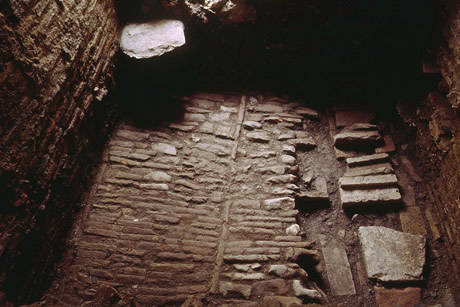 The remains of these Arab baths are located near Elvira Gate,
at the beginning of Calle Elvira.
The remains of these Arab baths are located near Elvira Gate,
at the beginning of Calle Elvira.
Known as the Arab Baths of Hernando de Zafra or the Baths of the House of Tombs, due to the impression their vaulted ceilings gave from the outside, they are believed to have been built between the 12th and 13th centuries.
After the Capture of Granada in 1492, they became the property of the secretary to the Catholic Monarchs, Hernando de Zafra, who renovated them for his personal use.
Unfortunately, at the beginning of the 20th century, most of their vaults, columns, and arches were demolished. Today, only the walls, some vaults with their characteristic octagonal or star-shaped skylights, and parts of the original floors remain.
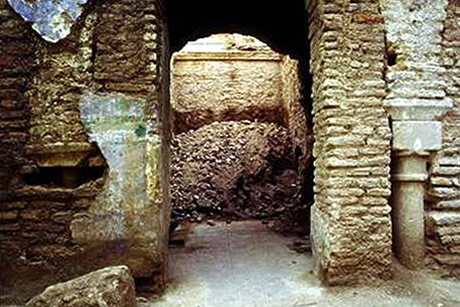 Through a hallway, on the right, there is a small room covered with a cylindrical vault and a skylight. This room communicated
with the changing room through a horseshoe arch.
Through a hallway, on the right, there is a small room covered with a cylindrical vault and a skylight. This room communicated
with the changing room through a horseshoe arch.
On the left side of the hallway, there is an L-shaped corridor that preserves two pointed arches and leads to the courtyard. Three arches and the perimeter wall of the tepidarium also remain standing. The caldarium is the best preserved.
Otherwise, nothing remains of these magnificent baths, which even had a garden with fountains. Its restoration is still pending in order to open it to the public.
Closed to the public.
Arab Baths in La Zubia Village (Nasrid period, 13th century)
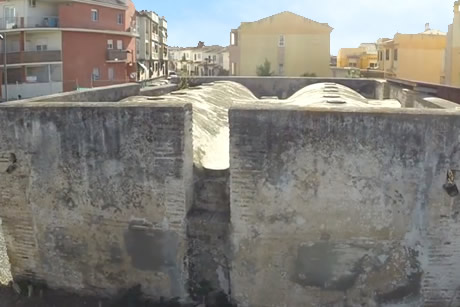 The name of this village (al-Zawiya) itself indicates that it was a special place serving as a retreat for the Arabs. In La Zubia,
several archaeological remains testify to its Muslim past: cisterns, irrigation channels, and Arab baths from the 12th and 13th centuries.
The name of this village (al-Zawiya) itself indicates that it was a special place serving as a retreat for the Arabs. In La Zubia,
several archaeological remains testify to its Muslim past: cisterns, irrigation channels, and Arab baths from the 12th and 13th centuries.
Of these Arab baths, only two rooms have been fully preserved: the tepidarium and the caldarium, both covered by vaults with star-shaped skylights.
The hypocaust, or heating system used to warm the room, stands out for its excellent state of preservation. It consists of a series of conical brick pillars located beneath the caldarium.
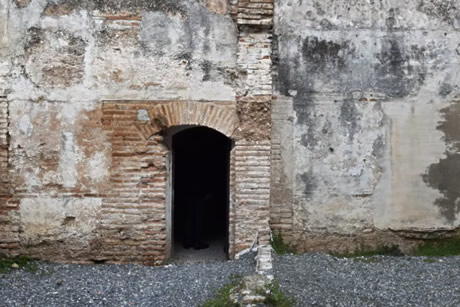 As is characteristic of rural Nasrid-era Arab baths, its structure is simple and functional. Built with very solid materials,
which have helped preserve these remains, and with little or no decoration.
As is characteristic of rural Nasrid-era Arab baths, its structure is simple and functional. Built with very solid materials,
which have helped preserve these remains, and with little or no decoration.
Remains of the boiler room, firewood storage, and the irrigation channel that brought water to the bath have also been excavated.
Entry is only available with guided tours organized by the Town Hall.
Page Updated: Nov 15, 2025
Was this useful? Been to these sights? Share your thoughts!
© Copyright •
LoveGranada.com • Any use of the content, including copying of it in whole or in part is prohibited.
You Might Also Be Interested In
Opinions about Arab Baths in Granada
Arab baths Aljibe
Something really worth seeing are the Arab baths Aljibe, amazing experience taking a bath while you hear a arab music and drink mint tea, relaxing massage, would feel something like Scheherazade's of the Arabian Nights (Mela).
Worth a visit
Arab baths are the best place to visit and relax in Granada. Great experience to take a bath while listening to music and drinking mint tea, very relaxing, and it's not expensive.

